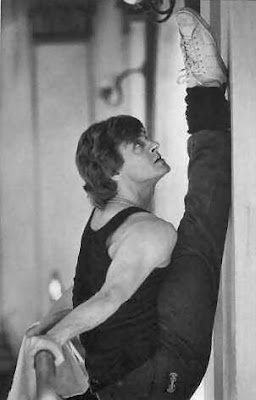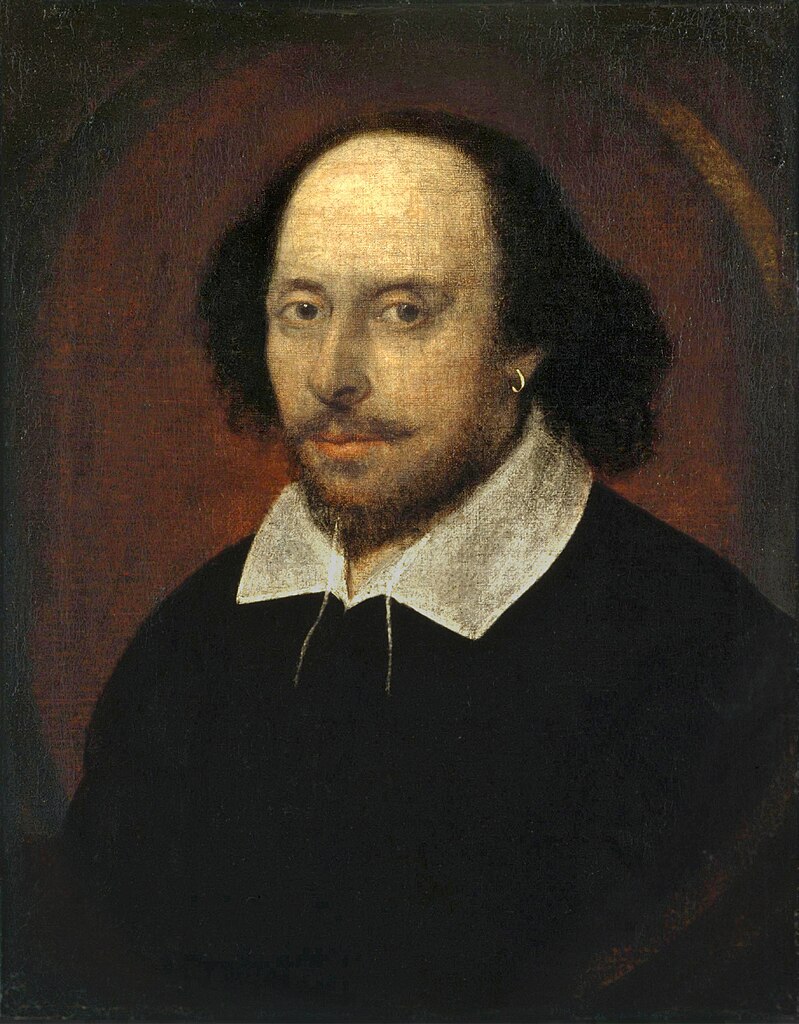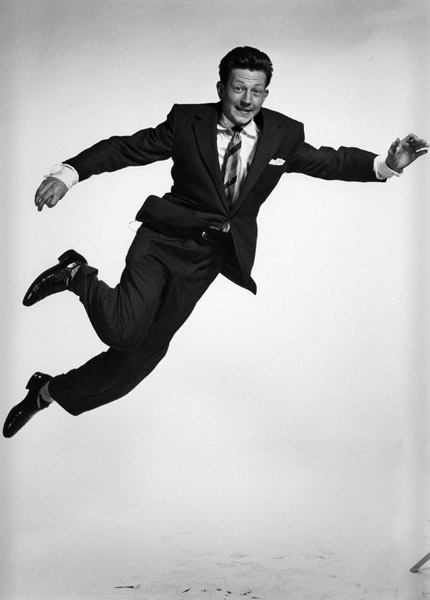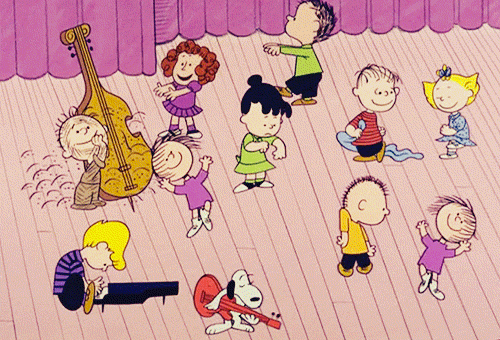Happy Friday Everyone!
Paper is not dead!
The Best Flash Mob EVER!
The star of Mission Impossible Five: Operation Nut Job
Best ways of describing life….


This is just AWESOME!

Paper is not dead!
The Best Flash Mob EVER!
The star of Mission Impossible Five: Operation Nut Job
Best ways of describing life….


This is just AWESOME!


No one is born a dancer.You have to want it more than anything.
Baryshnikov was born in Riga, Latvia, then occupied and annexed by the Soviet Union. His parents were Russian, Alexandra (a dressmaker; maiden name, Kisselova) and Nicholai Baryshnikov (an engineer). Baryshnikov began his ballet studies in Riga in 1960. In 1964, he entered the Vaganova School, in what was then Leningrad (now St. Petersburg). Baryshnikov soon won the top prize in the junior division of the Varna International Ballet Competition. He joined the Kirov Ballet and Mariinsky Theater in 1967, dancing the “Peasant” pas de deux in Giselle.
Recognizing Baryshnikov’s talent, in particular the strength of his stage presence and purity of his classical technique, several Soviet choreographers, including Oleg Vinogradov, Konstantin Sergeyev, Igor Tchernichov, and Leonid Jakobson, choreographed ballets for him. Baryshnikov made signature roles of Jakobson’s 1969 Vestris along with an intensely emotional Albrecht in Giselle. While still in the Soviet Union, he was called by New York Times critic Clive Barnes “the most perfect dancer I have ever seen.”
On June 29, 1974, while on tour in Canada with the Kirov Ballet, Baryshnikov defected, requesting political asylum in Toronto, and joined the Royal Winnipeg Ballet. He also announced to the dance world he would not go back to the U.S.S.R. He later stated that Christina Berlin, an American friend of his, helped engineer his defection during his 1970 tour of London. His first televised performance after coming out of temporary seclusion in Canada was with the National Ballet of Canada in La Sylphide. He then went on to the United States.
From 1974 to 1978, he was principal dancer with the American Ballet Theatre (ABT), where he partnered with Gelsey Kirkland. He also worked with the New York City Ballet, with George Balanchine and as a regular guest artist with the Royal Ballet. He also toured with ballet and modern dance companies around the world for fifteen months. Several roles were created for him, including roles Opus 19: The Dreamer (1979), by Jerome Robbins, Rhapsody (1980), by Frederick Ashton, and Other Dances with Natalia Makarova by Jerome Robbins.
He returned to ABT in 1980 as dancer and artistic director, a position he held for a decade. On July 3, 1986, he became a naturalized citizen of the United States. From 1990 to 2002, Baryshnikov was artistic director of the White Oak Dance Project, a touring company he co-founded with Mark Morris. In 2003, he won the Prix Benois de la Danse for lifetime achievement. In 2005 he launched the Baryshnikov Arts Center in New York.
Baryshnikov made his American television dancing debut in 1976, on the PBS program In Performance Live from Wolf Trap. During the Christmas season of 1977, CBS brought his highly acclaimed American Ballet Theatre production of Tchaikovsky’s classic ballet The Nutcracker to television, and it has remained to this day the most popular and most often shown television production of the work, at least in the U.S. In addition to Baryshnikov in the title role, Gelsey Kirkland, Alexander Minz, and many members of the American Ballet Theatre also starred. The production is still shown by some PBS stations. The Baryshnikov version of The Nutcracker is one of only two to be nominated for an Emmy Award. The other one was Mark Morris’ The Hard Nut, Morris’s intentionally exaggerated and satirical version of the ballet.
Baryshnikov also performed in two Emmy-winning television specials, one on ABC and one on CBS, in which he danced to music from Broadway and Hollywood, respectively. During the 1970’s and 1980’s, he appeared many times with American Ballet Theatre on Live from Lincoln Center and Great Performances. Over the years, he has also appeared on several telecasts of the Kennedy Center Honors.
Baryshnikov performed in his first film role soon after arriving in New York. He portrayed the character Yuri Kopeikine, a famous Russian womanizing ballet dancer, in the 1977 film The Turning Point, for which he received an Oscar nomination. He co-starred with Gregory Hines and Isabella Rossellini in the 1985 film White Nights, choreographed by Twyla Tharp; and he was featured in the 1987 film Dancers. On television, in the last season of Sex and the City, he played a Russian artist, Aleksandr Petrovsky, who woos Carrie Bradshaw relentlessly and takes her to Paris. He co-starred in Company Business (1991) with Gene Hackman.
On November 2, 2006, Baryshnikov and chef Alice Waters were featured on an episode of the Sundance Channel’s original series Iconoclasts. The two have a long friendship. They discussed their lifestyles, sources of inspiration, and social projects that make them unique. During the program, Alice Waters visited Baryshnikov’s Arts Center in New York City. The Hell’s Kitchen Dance tour brought him to Berkeley to visit Alice Waters’ restaurant Chez Panisse.
On July 17, 2007, the PBS News Hour with Jim Lehrer featured a profile of Baryshnikov and his Arts Center.
On April 11–21, 2012, Baryshnikov starred in a new play directed by Dmitry Krymov, titled In Paris. The play was presented in the Santa Monica College Performing Arts Center, at the Broad Stage. His co-star was Anna Sinyakina.
His next role was the stage adaptation of Anton Chekhov’s Man in a Case.
Duo Dance from White Nights with Gregory Hines
Albrechts’ variation from Act II of Giselle in 1977.
Mikhail Baryshnikov in White Nights, dancing “Koni” (Horses) by Vysotsky (KGB spy and killer).
Danced with the Kirov Ballet, the American Ballet Theatre and the New York City Ballet.
Was artistic director with ABT and even ran his own class outside of ABT – Mikhail Baryshnikov’s School of Classic Ballet.
Was romantically involved with legendary ballerinas Natalia Makarova and Gelsey Kirkland.
Frequently attended legendary New York disco Studio 54.
Was nominated for Broadway’s 1989 Tony Award as Best Actor (Play) for “Metamorphosis.”
Owner of ballet troupe, “White Oak Dance Project”.
Taught by ballet instructor Bella Kovarsky when he was a child.
Mikhail was a 2000 recipient of the John F. Kennedy Center Honors.
Keone & Mariel Madrid: “Is This Love” by Bob Marley Choreography
Dog sings to crying baby
Hey There Delilah…with a twist

Yep, you know you’ve been there….

20 Words We Owe to Shakespeare ( Forgot one…Green-eyed Monster)!
http://mentalfloss.com/article/48657/20-words-we-owe-william-shakespeare
In Celebration of the new season of Downton Abbey
A Touching Tribute to Chick-Fil-A
10 Famous Movie Misquotes



My mother gave me my drive but my father gave me my dreams
Liza Minnelli was born on March 12, 1946, the daughter of Judy Garland and movie director Vincente Minnelli. She was practically raised at MGM studios while her parents worked long hours there and she made her film debut at fourteen months of age in the movie In the Good Old Summertime (1949). Her parents divorced in 1951 and, in 1952, her mother married Sidney Luft, with sister Lorna Luft and brother Joey Luft subsequently being born. Her father, Vincente Minnelli, later married Georgette Magnani, mother of her half-sister Christiane Nina “Tina Nina” Minnelli.
At sixteen, Liza was on her own in New York City, struggling to begin her career in show business. Her first recognition came for the play “Best Foot Forward” which ran for seven months in 1963. A year later, Judy invited Liza to appear with her for a show at the London Paladium. This show sold out immediately and a second night was added to it. Liza’s performance in London was a huge turning point in both her career and her relationship with her mother. The audience absolutely loved Liza and Judy realized that Liza was now an adult with her own career. It was at the Paladium that Liza met her first husband, Peter Allen, a friend of Judy’s.
Liza won a Tony award at age nineteen and was nominated for her first Academy Award at age twenty-three for the role of Pookie Adams in The Sterile Cuckoo (1969). Other dramatic roles followed and, in 1972, she won an Oscar for her performance as Sally Bowles in the movie Cabaret (1972). The seventies were a busy time for Liza. She worked steadily in film, stage and music. She and good friend Halston were regulars at Studio 54, the trendiest disco club in the world. Marriages to filmmaker Jack Haley Jr. and Mark Gero, a sculptor who earned his living in the theater followed. Each marriage ended in divorce.
Over the past years, her career has leaned more towards stage performances and she has a long list of musical albums which she continues to add to. She teamed with Frank Sinatra in his “Duets” CD and Sammy Davis Jr. joined them for a series of concerts and TV shows which were extremely well-received.
She has had to deal with tabloid stories of drug abuse and ill-health and has had a number of high profile stays at drug-rehabilitation clinics. Her hectic schedule may have slowed down in recent years, but she still has a large following of immensely loyal fans who continue to cheer her on.
Liza Minnelli on the Judy Garland Show
Baryshnikov and Minnelli
Stepping Out
Her parents named her after Ira Gershwin’s song “Liza (All the Clouds’ll Roll Away)”
Says her mother gave her a sense of humor
1990: She received the Grammy Legend Award, making her one of the few artists who have won entertainment’s top four awards – the Oscar, the Tony, The Emmy and the Grammy.
Was briefly managed by KISS lead singer/guitarist Gene Simmons in the 1980s.
When she was young she befriended Marilyn Monroe.
Her mother, Judy Garland, and former father-in-law, Jack Haley, starred together in The Wizard of Oz (1939).
She and her mother, Judy Garland, were the first Oscar-nominated mother and daughter.
Godparents were Ira Gershwin and Kay Thompson.
Because Liza constantly traveled with her mother, she spent most of her childhood in hotels. She was the inspiration for the character of “Eloise”, who grew up in the Plaza Hotel. The books were written by Liza’s godmother, Kay Thompson.
While Frank Sinatra’s version of “New York, New York” is played at Yankee Stadium after every Yankee home win, Liza Minnelli’s version is played after every Yankee home loss.
Her favorite modern-day singers are Adele, Michael Bublé, Pink and ‘Lady GaGa’.

Bio-metric key less locks let you unlock or lock your entry door
with just a quick scan of your fingerprint.

Why not decorate cables when you can’t hide them?

Personal Fondue Mugs

Who says there’s no room for a chess board?

Transparent Toaster gives you clear view of bread’s crispiness
(About time!)

Got a small apartment? No problem!
Mini Mexican Pizzas!

Pesto Pasta with Sun Dried Tomatoes and Roasted Asparagus


Broccoli, Ham, and Mozzarella Baked with Eggs Casserole


Um…YUM!


I was born and raised to entertain other people. I’ve heard laughter and applause and known a lot of sorrow. Everything about me is based on show business – I think it will bring me happiness. I hope so.
Though he considered Danville, Illinois to be his home town, O’Connor was born in St. Elizabeth Hospital in Chicago. His parents, Effie Irene (née Crane) and John Edward “Chuck” O’Connor, were vaudeville entertainers. His father’s family was from County Cork, Ireland.[3] When O’Connor was only a few years old, he and his sister Arlene were in a car crash outside a theater in Hartford, Connecticut; O’Connor survived, but his sister was killed. Several weeks later, his father died of a heart attack while dancing on stage in Brockton, Massachusetts.[4] O’Connor at the time was being held in the arms of the theater manager, Mr. Maurice Sims.
O’Connor began performing in movies in 1937. He appeared opposite Bing Crosby in Sing You Sinners at age 12. Paramount Pictures used him in both A and B films, including Tom Sawyer, Detective and Beau Geste. In 1940, when he had outgrown child roles, he returned to vaudeville. In 1942, O’Connor joined Universal Pictures where he played roles in four of the Gloria Jean musicals, and achieved stardom with Mister Big (1943).
In 1944, O’Connor was drafted into the Army. Before he reported for induction, Universal Pictures rushed him through production of three feature films simultaneously and released them when he was overseas. After his discharge, Universal (now reorganized as Universal-International) cast him in lightweight musicals and comedies.
In 1949, he played the lead role in Francis, the story of a soldier befriended by a talking mule. The film was a huge success. As a consequence, his musical career was constantly interrupted by production of one Francis film per year until 1955. It was because of the Francis series that O’Connor missed playing Bing Crosby’s partner in White Christmas. O’Connor was unavailable because he contracted an illness transmitted by the mule, and was replaced in the film by Danny Kaye.
O’Connor’s role as Cosmo the piano player in Singin’ in the Rain earned him a Golden Globe Award for Best Performance by an Actor in a Comedy or Musical. The film featured his memorable rendition of Make ‘Em Laugh. O’Connor was a regular host of NBC‘s Colgate Comedy Hour. He hosted a color television special on NBC in 1957, one of the earliest color programs to be preserved on a color kinescope; an excerpt of the telecast was included in NBC’s 50th anniversary special in 1976. In 1954, he starred in his own television series, The Donald O’Connor Show on NBC. In 1968, O’Connor hosted a syndicated talk show also called The Donald O’Connor Show.
O’Connor overcame alcoholism after being hospitalized in 1978. His career had a boost when he hosted the Academy Awards, which earned him two Primetime Emmy nominations. He appeared as a gaslight-era entertainer in the 1981 film Ragtime, notable for similar encore performances by James Cagney and Pat O’Brien. It was his first feature film role in 16 years.
O’Connor appeared in the short-lived Bring Back Birdie on Broadway in 1981, and continued to make film and television appearances into the 1990s, including the Robin Williams film Toys as the president of a toy-making company. He had guest roles in 1996 in a pair of popular TV comedy series, The Nanny and Frasier.
In 1998, he received a Golden Palm Star on the Palm Springs, California, Walk of Stars. O’Connor’s last feature film was the Jack Lemmon–Walter Matthau comedy Out to Sea, in which he played a dance host on a cruise ship. O’Connor was still making public appearances well into 2003.
The most distinctive characteristic of O’Connor’s dancing style was its athleticism, for which he had few rivals. Yet it was his boyish charm that audiences found most engaging, and which remained an appealing aspect of his personality throughout his career. In his early Universal films, O’Connor closely mimicked the smart alec, fast talking personality of Mickey Rooney of rival MGM Studio. For Singin’ in the Rain, however, MGM cultivated a much more sympathetic sidekick persona, and that remained O’Connor’s signature image.
O’Connor nearly died from pneumonia in January 1998. He died from complications of heart failure on September 27, 2003 at age 78 at the Motion Picture & Television Country House and Hospital, in Woodland Hills, California. His remains were cremated and buried at the Forest Lawn–Hollywood Hills Cemetery in Los Angeles. O’Connor was survived by his wife, Gloria, and four children. Gloria O’Connor died from natural causes on June 4, 2013, aged 84.
Incredible balloon dance!
Make ‘Em Laugh from Singin’ in the Rain
Walking My Baby Back Home
Judy Garland, whom he knew as a child, was one of his best friends.
Was suppose to co-star with Bing Crosby in the perennial film classic White Christmas(1954) in 1954 but was sidelined with pneumonia and replaced by Danny Kaye.
Allegedly didn’t enjoy working with Gene Kelly while filming Singin’ in the Rain (1952), because he found him to be a bit of a tyrant on set.
Made his film debut at age 12 in Melody for Two (1937) with his two brothers, Jack O’Connor and Billy O’Connor, doing a specialty routine. Billy died a year or two later after contracting scarlet fever.
Despite failing health in 2003, he made appearances at the Roger Ebert Overlooked Film Festival and the opening of the Judy Garland Museum.
While he’s hesitant to select a favorite film, he’s quick to single out his favorite performance: “Call Me Madam (1953) – my favorite number is in there with Vera-Ellen. It’s the number I do out in the garden with her to “It’s a Lovely Day Today”. It’s a beautiful lyrical number. I think she was the best dancer outside of Peggy Ryan I ever danced with”.
Merry Christmas Eve Framers!
Judy Garland!

One of the brightest, most tragic movie stars of Hollywood’s Golden Era, Judy Garland was a much-loved character whose warmth and spirit, along with her rich and exuberant voice, kept theatre-goers entertained with an array of delightful musicals.
She was born Frances Ethel Gumm on 10 June 1922 in Minnesota, the youngest daughter of vaudevillians Frank and Ethel Gumm. Her mother, an ambitious woman gifted in playing various musical instruments, saw the potential in her daughter at the tender age of just 2 years old when Baby Frances repeatedly sang “Jingle Bells” until she was dragged from the stage kicking and screaming during one of their Christmas shows and immediately drafted her into a dance act, entitled “The Gumm Sisters”, along with her older sisters Mary Jane Gumm and Virginia Gumm. However, knowing that her youngest daughter would eventually become the biggest star, Ethel soon took Frances out of the act and together they traveled across America where she would perform in nightclubs, cabarets, hotels and theaters solo.
Her family life was not a happy one, largely because of her mother’s drive for her to succeed as a performer and also her father’s closeted homosexuality. The Gumm family would regularly be forced to leave town owing to her father’s illicit affairs with other men, and from time to time they would be reduced to living out of their automobile. However, in September 1935 the Gumms’, in particular Ethel’s, prayers were answered when Frances was signed by Louis B. Mayer, mogul of leading film studio MGM, after hearing her sing. It was then that her name was changed from Frances Gumm to Judy Garland, after a popular ’30s song “Judy” and film critic Robert Garland. Judy’s career did not officially kick off until she sang one of her most famous songs, “You Made Me Love You”, at Clark Gable‘s birthday party in February 1937, during which Louis B. Mayer finally paid attention to the talented songstress.
Prior to this her film debut in Pigskin Parade (1936), in which she played a teenage hillbilly, had left her career hanging in the balance. However, following her rendition of “You Made Me Love You”, MGM set to work preparing various musicals with which to keep Judy busy. All this had its toll on the young teenager, and she was given numerous pills by the studio doctors in order to combat her tiredness on set. Another problem was her weight fluctuation, but she was soon given amphetamines in order to give her the desired streamlined figure. This soon produced the downward spiral that resulted in her lifelong drug addiction.
In 1939, Judy shot immediately to stardom with The Wizard of Oz (1939), in which she portrayed Dorothy, an orphaned girl living on a farm in the dry plains of Kansas who gets whisked off into the magical world of Oz on the other end of the rainbow. Her poignant performance and sweet delivery of her signature song, ‘Over The Rainbow’, earned Judy a special juvenile Oscar statuette on 29 February 1940 for Best Performance by a Juvenile Actor. Now growing up, Judy began to yearn for meatier adult roles instead of the virginal characters she had been playing since she was 14.
By this time, Judy had starred in her first adult role as a vaudevillian during WWI in For Me and My Gal (1942). In November 1943, Judy began filming Meet Me in St. Louis (1944), which proved to be a big success. The director Vincente Minnelli highlighted Judy’s beauty for the first time on screen, having made the period musical in color, her first color film since The Wizard of Oz (1939). He showed off her large brandy-brown eyes and her full, thick lips and after filming ended in April 1944, a love affair resulted between director and actress and they were soon living together. Vincente began to mold Judy and her career, making her more beautiful and more popular with audiences worldwide. He directed her in The Clock (1945), and it was during the filming of this movie that the couple announced their engagement on set on 9 January 1945.
But married life was never the same for Vincente and Judy after they filmed The Pirate (1948) together in 1947. Judy’s mental health was fast deteriorating and she began hallucinating things and making false accusations toward people, especially her husband, making the filming a nightmare. She then teamed up with dancing legend Fred Astaire for the delightful musical Easter Parade(1948), which resulted in a successful comeback despite having Vincente fired from directing the musical. Afterwards, Judy’s health deteriorated and she began the first of several suicide attempts. In May 1949, she was checked into a rehabilitation center, which caused her much distress.
On returning, Judy made In the Good Old Summertime (1949), which was also Liza’s film debut, albeit via an uncredited cameo. She had already been suspended by MGM for her lack of cooperation on the set of The Barkleys of Broadway (1949), which also resulted in her getting replaced by Ginger Rogers. After being replaced by Betty Hutton on Annie Get Your Gun (1950), Judy was suspended yet again before making her final film for MGM, entitled Summer Stock (1950). At 28, Judy received her third suspension and was fired by MGM, and her second marriage was soon dissolved.
Judy signed a film contract with Warner Bros. to star in the musical remake of A Star Is Born (1937), which had starred Janet Gaynor, who had won the first-ever Academy Award for Best Actress in 1929. She won a Golden Globe for her brilliant and truly outstanding performance as Esther Blodgett, nightclub singer turned movie star, but Judy lost out on the Best Actress Oscar to Grace Kelly for her portrayal of the wife of an alcoholic star in The Country Girl (1954).
At age 41, she made her final performance on film alongside Dirk Bogarde in I Could Go on Singing (1963). She continued working on stage, appearing several times with her daughter Liza. It was during a concert in Chelsea, London, that Judy stumbled into her bathroom late one night and died of an overdose of barbiturates, the drug that had dominated her much of her life, on the 22nd of June 1969 at the age of 47.She is still an icon to this day with her famous performances in The Wizard of Oz (1939), Meet Me in St. Louis (1944), Easter Parade (1948), and A Star Is Born (1954).


A New Twist to an Old Favorite! HAHA!
The USAF Band Christmas Flash Mob at the National Air and Space Museum (WOW!)
What Christmas is all a about…